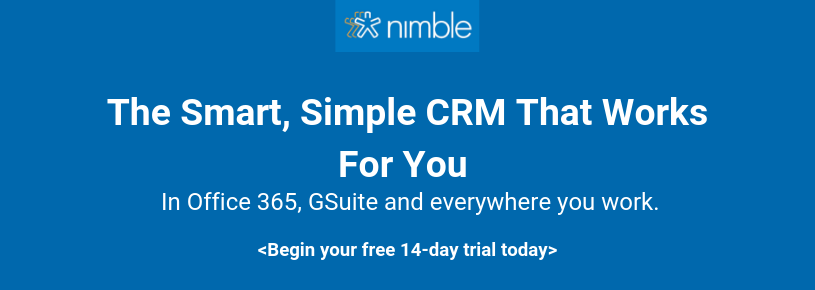Are you interested in generating more sales for your eCommerce business?
It sounds counterintuitive but the most cost-effective way to do this is to focus on the segment who have abandoned their cart. These are the people who are just about to buy but just need that extra push.
These customers have the intent of buying but are often sidetracked by other distractions. As an eCommerce marketer, your goal is to bring them back to your site and convert.
Abandoned carts are a lot more common online than offline – as a matter of fact, a mind-numbing 76% of shoppers abandon their carts.
The solution – abandoned cart email sequences.
Once you set them up, they practically run on autopilot, and you’ll start seeing results almost immediately.
In this article, we’ll be going through four abandoned cart email examples and the proven strategies each one has put in place to ensure your customer checks out. Let’s first understand why customers are abandoning carts in the first place.
Why are customers abandoning carts?
Every eCommerce store is different, but most of them share the same common issues that lead to cart abandonment. It is incredibly frustrating leading a potential customer through an entire sales funnel only to lose them at the final step.
Unexpected costs that show up during checkout make a lot of customers rethink their purchase. Once a customer sees the added fees, they are less likely to make the purchase. The solution to this is to give customers all costs upfront to avoid last-minute surprises.
One of the main reasons customers abandon payment is a long and intricate checkout process. Make the aim of reducing the steps and minimizing data entry to make the process more streamlined. Autosave capabilities and auto-fill forms work like a charm.
I don’t know about you, but I detest the idea of creating an account to add items to a virtual shopping cart. All this does is break the purchase cycle by including an additional step, which leads away some customers.
In eCommerce, never force account creation. In fact, 23% of users will abandon their shopping cart if they have to create a new user account. Instead, opt for guest checkout. If you’re interested in collecting contact information or emails, do it after the purchase is complete.
After sorting out the above issues, make sure that you offer as many payment options as you can, a variety of shipping options, and good return policies.
Unfortunately, even with such an optimized web store, abandoned carts will still be your nemesis as an eCommerce entrepreneur. Luckily, there are some abandoned cart email strategies you can use to win back customers.
Four abandoned cart email strategies
In most cases, you will need to integrate email marketing software into your online shop prior to sending abandoned cart email sequences. Good software allows you to customize each email and even create time-sensitive, personalized coupon codes to tip the odds in your favor.
Beyond just the tools you also need a strategy.
Here are four specific ones – offering support, using discounts, including customer reviews and crafting simple emails that you can employ for your eCommerce store.
I’ve also included some examples so that you can see how it works in practice.
Offer Support
There are lots of reasons why people abandon shopping carts. Since an email covering all the points would be ineffective, it would be better to include your contact information for people who would like to ask more questions.
Approach the first email as a customer service email, not a sales email.
Huckberry does it this way.
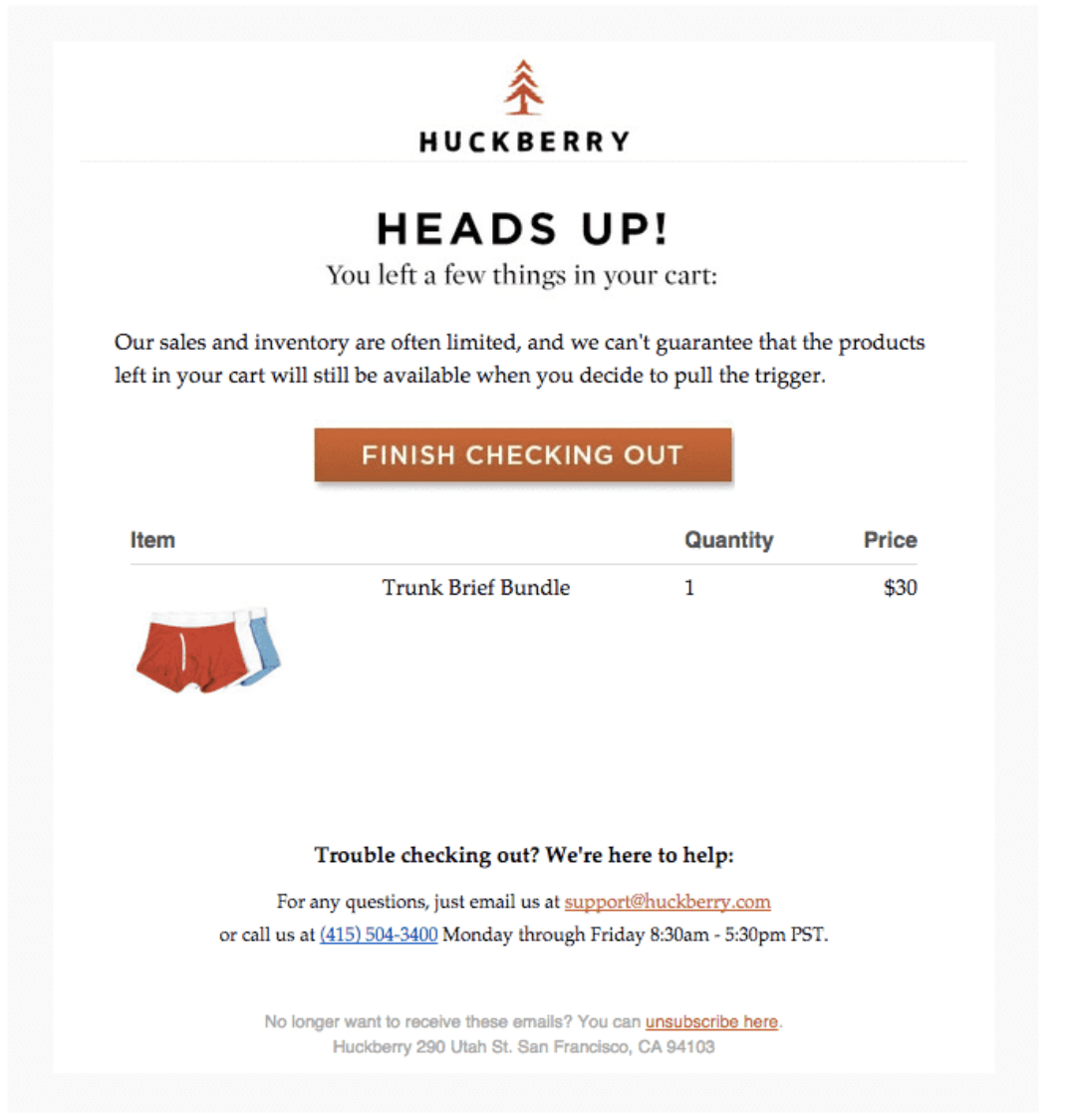
As you can see, they are reminding you to check out while still acknowledging the fact that you may have run into issues during checkout.
They have also included two different ways to speak with a customer service agent. I highly recommend also putting up a live chat option for customers who need help right away. The sooner you can resolve client issues, the more likely they are to complete their checkout.
Be sure to ask customer service focused questions such as, “Was there a problem?”.
The feedback you get is priceless for your conversion optimization efforts.
Qualitative feedback from clients will also unearth the friction points in your checkout process, and you’ll be able to see what is keeping customers from checking out. You can then correct the issues that are leading your clients to abandon their carts.
Employ Discounts and Offers Strategically
Discounts are a fantastic strategy to get people to complete their orders. However, using discounts also has its pitfalls.
One of the most common drawbacks of this is training your customers to abandon carts on purpose to receive discounts. Getting 10% off each order since you ‘forgot’ to check out doesn’t sound so bad. Luckily, there is a way around this by the use of frequency capping. This helps you identify the sneaky customers who are abusing the loophole and stops discount emails from being sent to them.
So, how about customers leaking discount codes to the public? There is also a solution for this. You can dynamically generate one-time use codes and make them unique to each customer. This way, the codes your customers get, can only be used one time.
Shown below is how Manta Sleep, a company dealing in sleeping masks, uses a discount as an incentive:
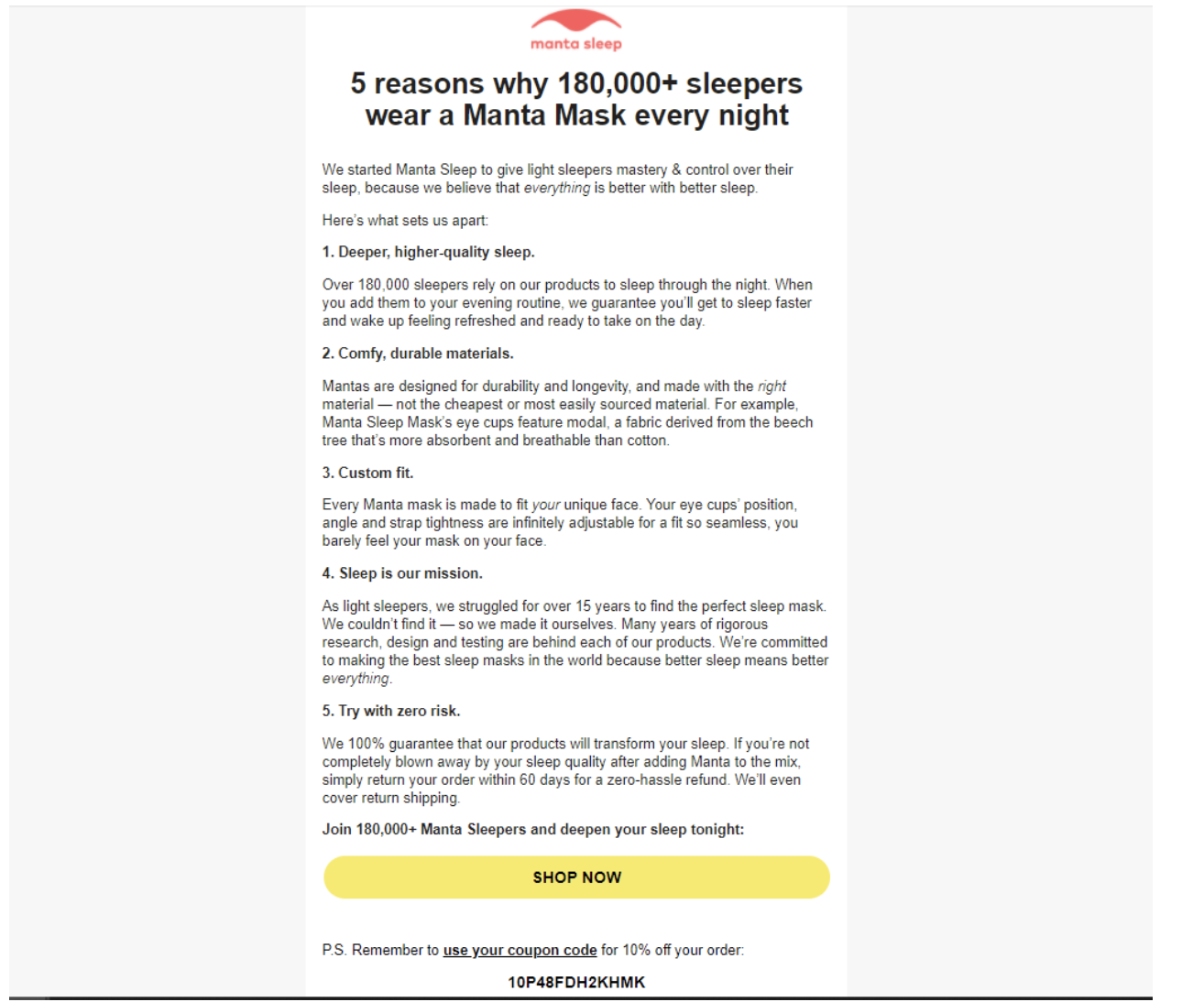
High-converting emails include scarcity. Customers are more likely to act if you mention that your products might be out of stock soon, or your discount code will expire. Manta Sleep does this very effectively in their second email below where they highlight and bold “this is your last chance to use your 10% off coupon.”
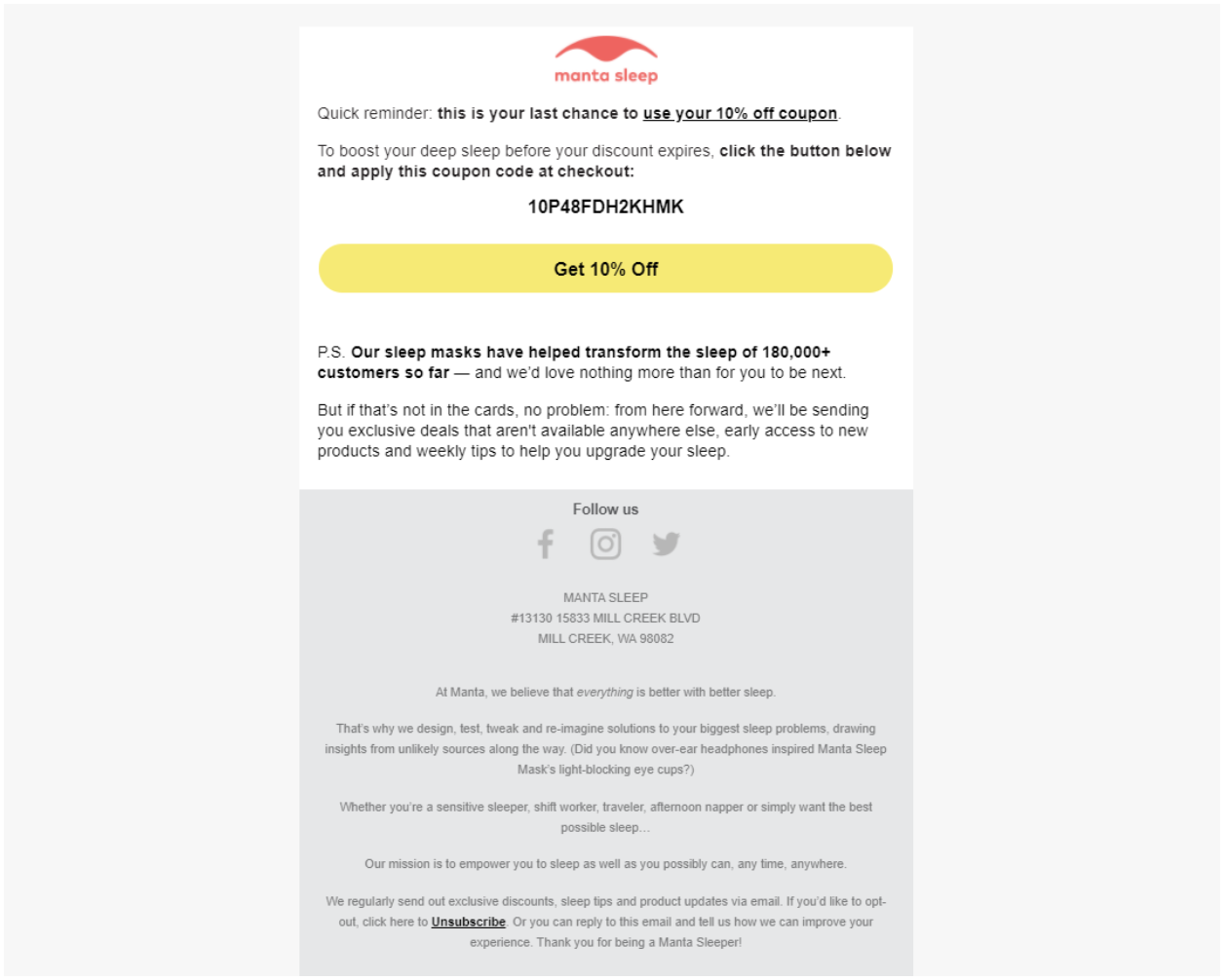
Include Customer Reviews and Testimonials
What is the first thing you do when you want to try a new eatery or reserve a hotel room?
Of course, you look up reviews.
Even when browsing Amazon for that new camera, you’ll still want to check reviews from others to make sure you are getting an awesome product. The reason why reviews and testimonials work wonders is that they rely on real people’s opinions. If a person is feeling a bit skeptical to go on with their purchase, a slight nudge with some testimonials might do the trick.
Cali Fabrics, a family-owned store dealing in fabrics and trims, knows this all too well.
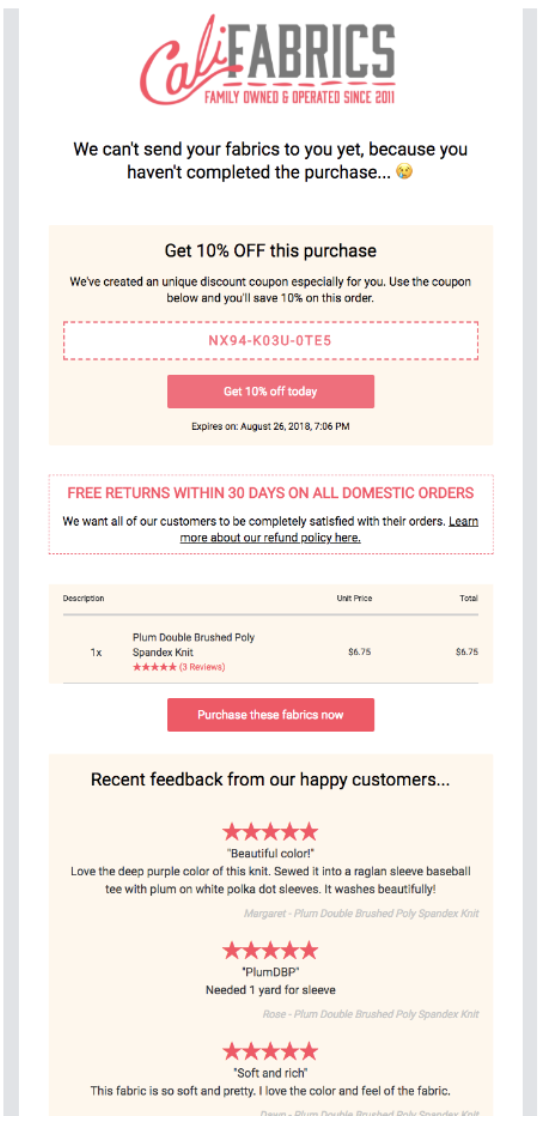
As simple as the email seems, they have incorporated a couple of powerful strategies to make it as effective as possible.
The testimonials are all focusing on the item in the cart, and you’re also getting a 10% discount. In addition to that, they are also offering free returns within 30 days. On top of all that, their email also matches the design of the company’s site. Cumulatively, this instills a sense of familiarity with the brand and goes a long way in crafting a good customer experience.
Simple and Specific
At times, shoppers tend to forget about their abandoned cart items. That said, some of the best-abandoned cart emails are the ones that remind people what they left in their cart.
Here’s an example of how to do that by Away Travel:
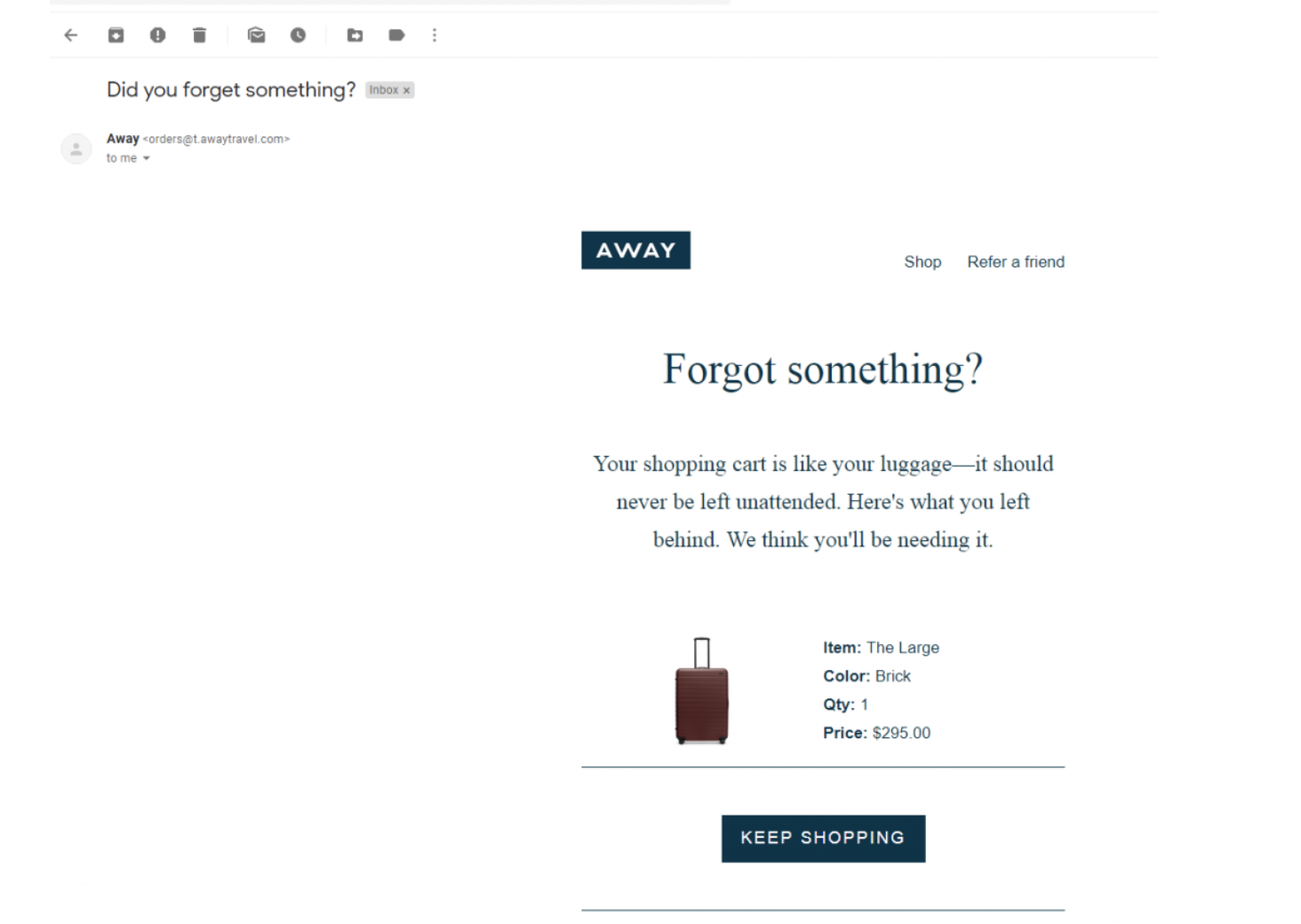
Showing people an actual photo of what they left in their cart personalizes the email while still reminding them what they are missing. People process and react to visuals much faster than words – take advantage of that.
It is also a good practice never to overload your customers with information. Concentrate on the bare minimum that is needed to return to their cart and make their purchase. Short emails are perfect as they hold the recipient’s attention just long enough to accomplish this.
Take this template, for instance:
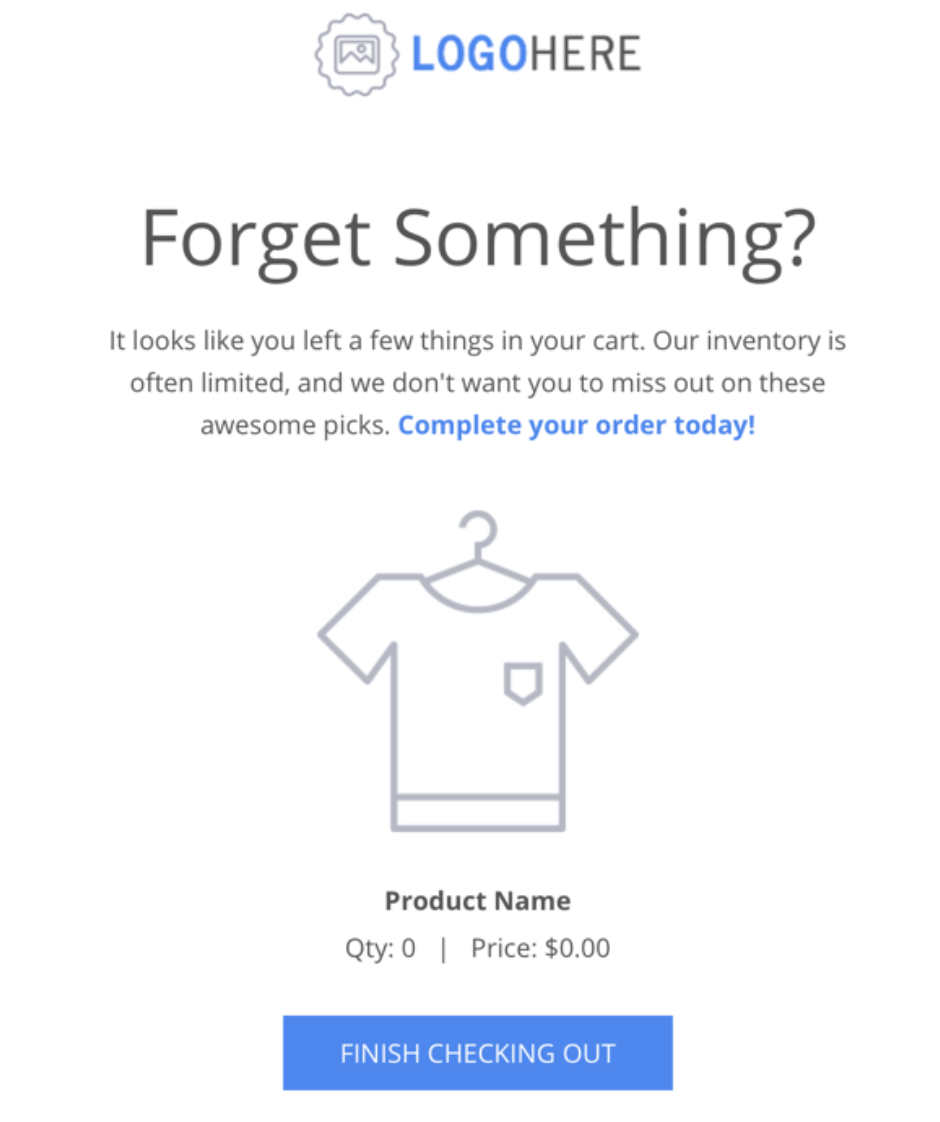
The email has no unnecessary information or CTA’s. Its sole focus is on the abandoned cart. Once the shopper receives the email, they’ll instantly see the product’s photo and price. If possible, include tracking on your links. Once your customer clicks on the link, you’ll want it to lead them to their cart, with the product already added.
Win Your Customers Back
Just because a shopper abandoned their cart doesn’t mean that they’re gone forever. With the right strategy, you can win back a lot of customers.
When writing this article, I abandoned more than a dozen carts. Only four stores followed up. Only two sent more than one email. I don’t even remember most of the companies that didn’t send recovery emails. Don’t be those businesses. Remember, 75% of shoppers who abandon their carts plan on coming back. You don’t want people to forget your store that soon.
Start converting seemingly missed opportunities to recovered sales by integrating a solid cart recovery campaign into your business.
I hope that these strategies have brought you closer to creating an abandoned cart recovery sequence that works for your business.
Do you have any experience with cart abandonment emails you’d like to share? We’re eager to hear from you down below.

